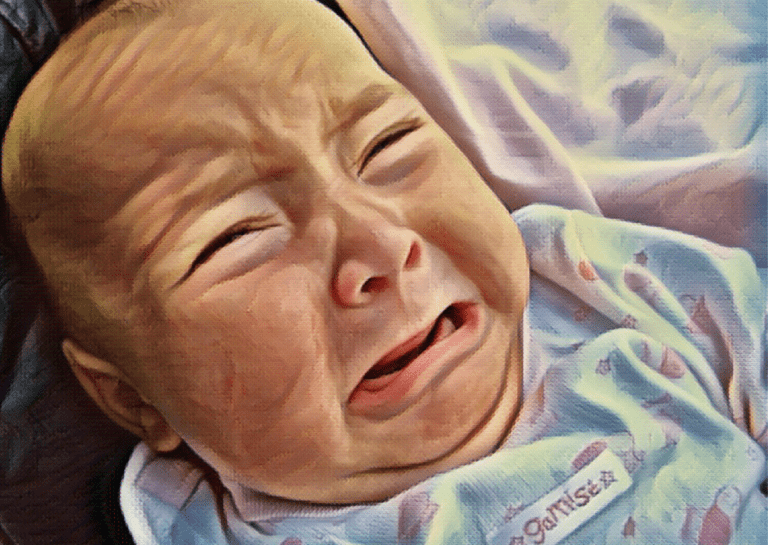For babies, crying is their only direct way of letting their parents know something is wrong. In fact, newborn babies can cry for 2 to 3 hours a day in their first 3 weeks. This can make it difficult for parents to determine what the root of the problem is.
Table of contents
Normal reasons for a baby to cry
Infants use crying as a signal to alert their caregivers to their wants and needs, so it’s completely normal for them to cry because they are hungry or tired. Here are the most common reasons for a baby to cry:
- Hunger
- Fatigue
- Dirty diaper
- Gas
- Need for attention
- Overstimulation
- Boredom
- Too hot/too cold
New parents often find it difficult to determine why their baby is crying during the first weeks and months, but they soon become accustomed to their baby’s desires.
Excessive crying
In their first weeks and months of life, babies can cry for anywhere between 1 and 3 hours a day. Because each baby is different, there is no clear consensus on what is considered to be “too much” crying. For parents concerned about seemingly excessive crying, it’s recommended to focus on the context and the quality of the crying rather than the duration. Ultimately, a parent or primary caretaker will come to understand what is and is not excessive for their baby.
Excessive crying in otherwise healthy babies is known as colic. With colic, the cause of the excessive crying is unclear which can be a source of concern for new parents. Crying that lasts for more than 3 hours a day and occurs more than 3 days a week in a baby under 3 months old is generally considered to be colic. The crying may also be louder than usual and uneven in pitch. Colicky crying tends to happen in the evening.
Possible causes of colic include:
- Improper feeding technique — Babies who are overfed, underfed, or who swallow excess air when being fed are prone to colic.
- Milk protein/Lactose intolerance — While the connection between colic and milk protein intolerance is not yet clear, it is recognized as a potential cause. The same can be said for lactose intolerance.
- Environmental factors — A stressful environment or maternal/paternal anxiety have been linked to cases of colic in infants.
Soothing a crying baby
Getting to the root of your baby’s crying is usually a case of trial and error. It’s often simply a matter of tending to their needs, be it feeding them, changing their diaper, or just giving them some affection, such as cuddling.
If you’re not sure what is upsetting them, take a trial and error approach. Offer them a bottle or try to breastfeed, check their diaper, or see if they have gas. Usually, you can get to the root of the problem and soothe a crying baby by responding to their needs.
What if your baby won’t stop crying?
If your baby is inconsolable no matter what you do, then it may be one of two relatively common issues. It can be both worrying and exhausting when your baby just can’t seem to settle, but by being aware of the following ailments, you can try to offer some relief.
- Reflux — If a baby seems to routinely cry after being fed, it could be acid reflux. You can help prevent reflux by using an upright feeding technique, using a curved bottle, and feeding in smaller amounts. Frequent burping may also help reduce reflux.
- Hair tourniquet — Although this is a less common occurrence, a hair tourniquet may be behind your baby’s constant crying when nothing else seems to be wrong. This happens when a strand of hair becomes tightly wrapped around a finger or toe, cutting off the blood supply. This causes swelling, pain, and irritability.
When to see a doctor
While crying is often a simple indicator of a baby’s needs, sometimes it can be something more serious. Check-in with a doctor if your baby:
- Has been crying for over 2 hours straight.
- Has been shaken or injured.
- Has a fever (100.4˚F).
- Is refusing to eat or drink.
- Is vomiting excessively.
References
Douglas, P., and P. Hill. “Managing Infants Who Cry Excessively in the First Few Months of Life.” BMJ, vol. 343, no. dec15 2, 2011, pp. d7772–d7772., doi:10.1136/bmj.d7772.
James-Roberts, Ian St, and Tony Halil. “Infant Crying Patterns in the First Year: Normal Community and Clinical Findings.” Journal of Child Psychology and Psychiatry, vol. 32, no. 6, 1991, pp. 951–968., doi:10.1111/j.1469-7610.1991.tb01922.x.
Lehtonen, Liisa A., and Päivi T. Rautava. “Infantile Colic: Natural History and Treatment.” Current Problems in Pediatrics, vol. 26, no. 3, 1996, pp. 79–85., doi:10.1016/s0045-9380(96)80015-6.
Templet, Tricia A., and Roger D. Rholdon. “Assessment, Treatment, and Prevention Strategies for Hair-Thread Tourniquet Syndrome in Infants.” Nursing for Women’s Health, vol. 20, no. 4, 2016, pp. 421–425., doi:10.1016/j.nwh.2016.06.005.
